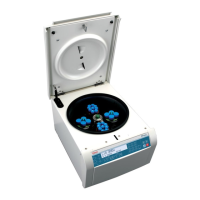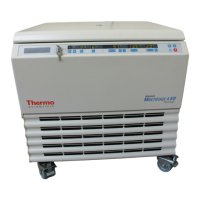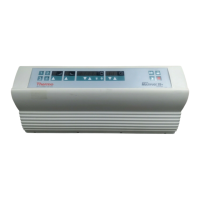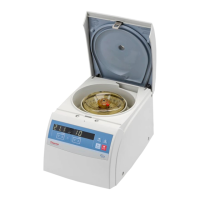
Do you have a question about the Thermo Scientific Heraeus Megafuge 16 Centrifuge and is the answer not in the manual?
| Max Speed | 16, 000 rpm |
|---|---|
| Power Requirements | 230 V, 50/60 Hz |
| Capacity | 4 x 250 mL |
| Temperature Range | –10 to 40 °C |
| Timer | Up to 99 hours |
| Noise Level | <60 dB |
Overview of the centrifuge's key features and operational capabilities.
Detailed specifications including environmental, electrical, and physical dimensions.
Compliance information regarding relevant electrical and quality standards.
Summary of the centrifuge's main functional components and their features.
Electrical connection data, including voltage, frequency, and fuse ratings.
List of available rotors and their corresponding catalog numbers for selection.
Initial steps to check the centrifuge and packaging for damage before setup.
Guidelines and safety warnings for safely moving the centrifuge.
Requirements for the installation site, including ventilation and stability.
Procedure for checking and ensuring the horizontal alignment of the centrifuge.
Steps and diagram for correctly connecting the centrifuge to the power supply.
Instructions for proper cleaning and storage of the centrifuge when not in use.
Detailed description and diagram of the centrifuge's control panel layout.
Explanation of each key on the control panel and their functions.
Procedure for powering on the centrifuge and initial display readouts.
Instructions on how to safely open the centrifuge lid using the designated key.
Steps for properly closing and securing the centrifuge lid.
Detailed guide on how to install and secure various types of rotors using the Auto-Lock system.
How to set speed, RCF, acceleration, braking curves, and temperature.
Steps to save custom program settings for future use.
Instructions for starting, running, and stopping the centrifugation process.
How the centrifuge maintains temperature when not actively running.
Using the PULSE function for brief centrifugation cycles.
Step-by-step instructions and visual guide for safely removing the rotor.
Final steps for aligning the centrifuge, involving turning off the power.
Detailed explanation of navigating and configuring system settings like language and beeps.
Recommended schedule for cleaning different parts of the centrifuge.
Step-by-step instructions for safely cleaning the centrifuge and its accessories.
Procedures for disinfecting the centrifuge, especially after spills of infectious material.
Methods for decontaminating the centrifuge from radioactive materials.
Guidelines for autoclaving rotors and accessories, including temperature and duration.
Information on recommended annual service and service contracts.
Procedure for manually opening the lid in case of power failure or malfunction.
Guide to identifying and resolving common failure messages and problems.
Information on when to seek professional support and how to provide necessary details.










